18 Best Fast-Growing Shrubs That Quickly Transform Your Yard
Super-powered shrubs that will thrive in record time.
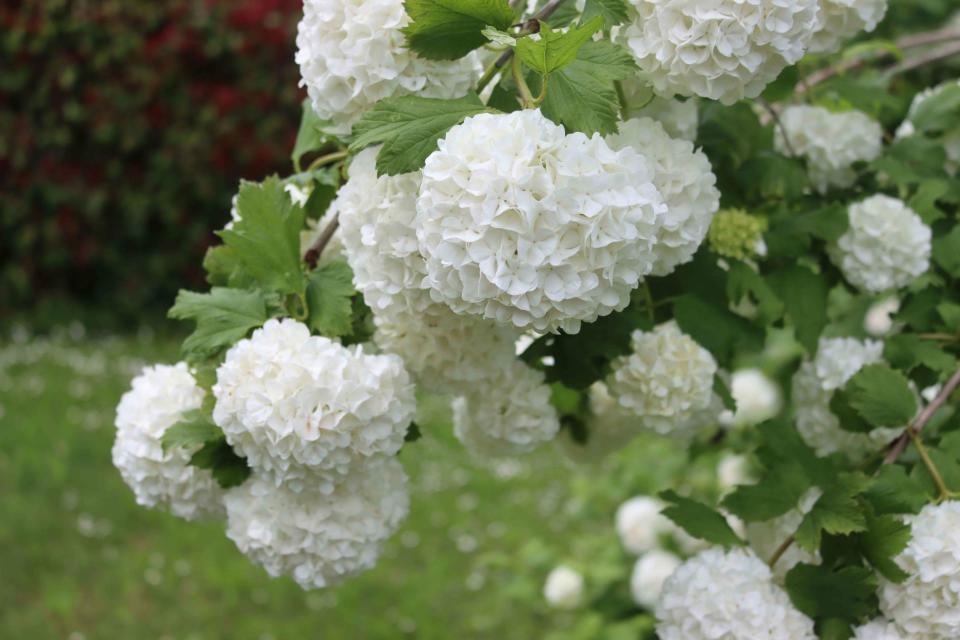
saraTM/Getty
Whether you’re looking for a fast-growing shrub for privacy, an evergreen shrub that will provide year-round color in your yard, or a flowering shrub to bring a gorgeous display of blooms in the spring and summer, this roundup of enthusiastic growers will make your dreams a reality in no time. These shrub varieties range from true, low-lying varieties to small trees that can be shaped and pruned to suit your space.
For each plant variety, we’ve given hardiness zones, sun exposure needs, and other notable details that can help ensure you find a fast-growing shrub that’s well-suited for your needs and climate. And, as you’ll find, there’s a wide variety to choose from. Now let’s talk about growth. Each and every one of our picks clock in between 2 feet to more than 3 feet of growth per year.
If you’re looking to put your garden on the fast track, these 18 fast-growing shrubs will get you there in no time.
Crepe Myrtle
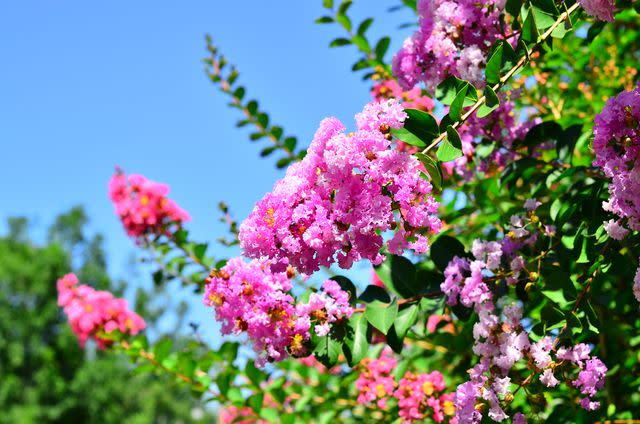
Shuiping Wang/Getty
Botanical Name: Lagerstroemia
Sun Exposure: Full
Soil Type: Well-drained, loamy, clay
Soil pH: Acidic, neutral (6.0-8.0)
USDA Hardiness Zone: 6-9
Growth Rate: 24 inches annually
While there are a variety of crepe myrtles to choose from, most fall within the shrub or small-tree category. They’re easy to grow and produce interest in the garden all year long, from long-lasting clusters of pink, white, or red blooms that start in June to their exfoliating bark in winter, the true calling card of this Southern classic. Expect lots of growth when given proper growing conditions. Plant where they'll receive full sun most of the day, and water every other week once established.
Related: How To Grow And Care For Crepe Myrtle
French Hydrangea
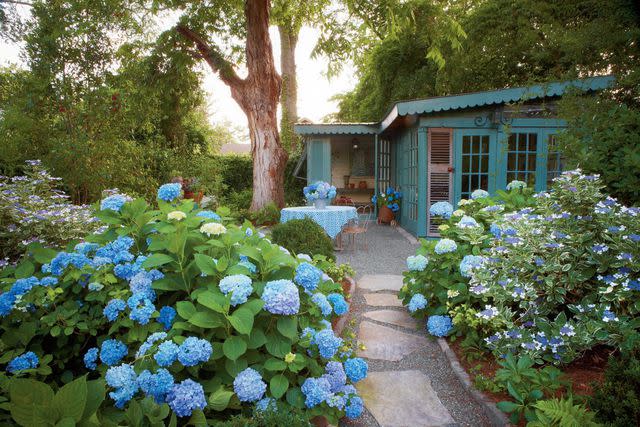
Botanical Name: Hydrangea Macrophylla
Sun Exposure: Partial
Soil Type: Moist, well-drained
Soil pH: Acidic, neutral (6.0-8.0)
USDA Hardiness Zone: 3-9
Growth Rate: 24 inches annually
The French hydrangea (also known as bigleaf hydrangea) is a showstopping shrub that produces profuse blooms in a colorful variety of mopheads or lacecaps in the summer. If you want the blooms to keep popping throughout the growing season, select a repeat-blooming variety that will flower on both old and new growth. Plant in well-draining soil amended with organic matter, and give them enough water so the top few inches of soil remain moist.
Related: How To Grow And Care For French Hydrangeas
North Privet
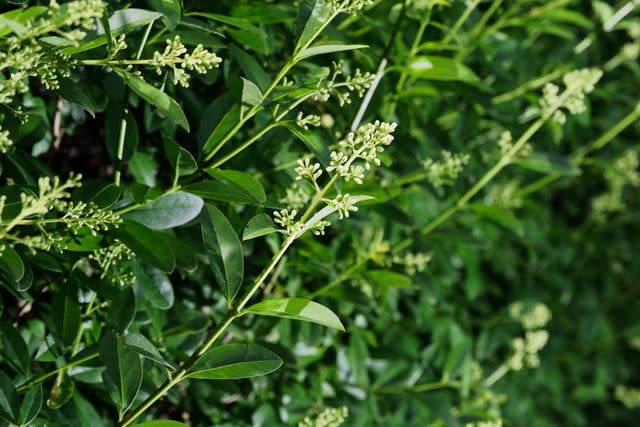
Dennis Gross / EyeEm / Getty
Botanical Name: Ligustrum x ibolium
Sun Exposure: Partial, full
Soil Type: Moist, well-drained
Soil pH: Acidic, neutral (6.0-8.0)
USDA Hardiness Zone: 4-8
Growth Rate: 3 feet per year
One of the fastest growing shrubs on this list, north privet matures rapidly to a height of up to 8 to 12 feet tall and 4 to 6 feet wide. Its appearance is characterized by a pyramid-like shape and glossy, dark green leaves. Plant this low-maintenance, fast grower as a privacy hedge. Pollinators are attracted to its fragrant white flowers. Beware of confusing north privet with its invasive cousin, Chinese privet (Ligustrum sinense).
Related: Everything You Need To Know About Privet
Old-Fashioned Weigela
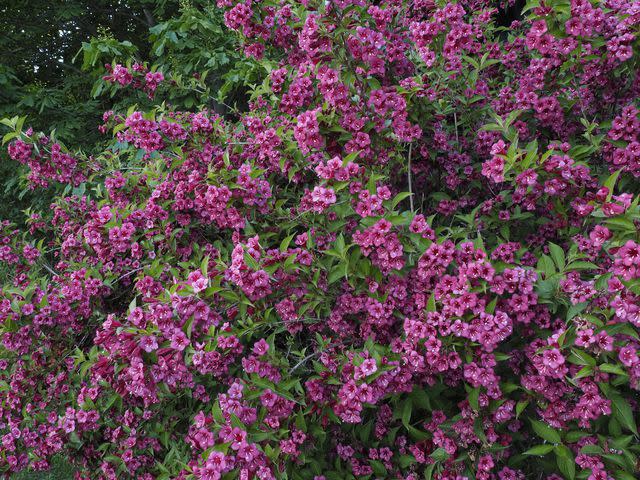
Federica Grassi/Getty
Botanical Name: Weigela florida
Sun Exposure: Partial, full
Soil Type: Moist, well-drained, loamy, clay, sandy
Soil pH: Acidic, neutral, alkaline (5.5-7.5)
USDA Hardiness Zone: 5-9
Growth Rate: 13-24 inches per year
While certainly not the fastest grower on this list, weigela shrubs are still a good choice for dense growth and relatively quick spread. They can reach their mature size within a few growing seasons. Bell-shaped, rosy pink flowers appear throughout April and May. Plant in full sun for the best foliage color, but Weigela also does well in dappled sunlight.
Forsythia
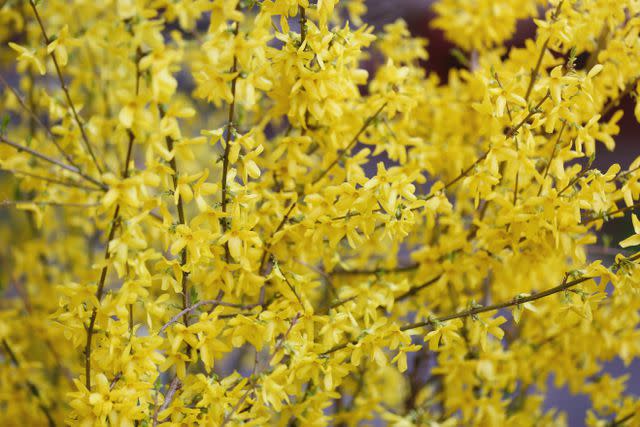
Elena Popova/Getty
Botanical Name: Forsythia x intermedia
Sun Exposure: Partial, full
Soil Type: Moist, well-drained
Soil pH: Acidic, neutral (6.0-7.0)
USDA Hardiness Zone: 5-8
Growth Rate: 24 inches per year
With upright, sometimes arching branches and a cloud of yellow blooms that flower on last year’s wood, the forsythia is an iconic sight in the South. It will grow in a rounded shape and reach a height of 8 to 10 feet in maturity. If you’re looking for a smaller variety, opt for a more compact form like the Show Off® Sugar Baby®. Forsythia can handle some drought and tolerate clay soil if it is amended.
Beauty Bush
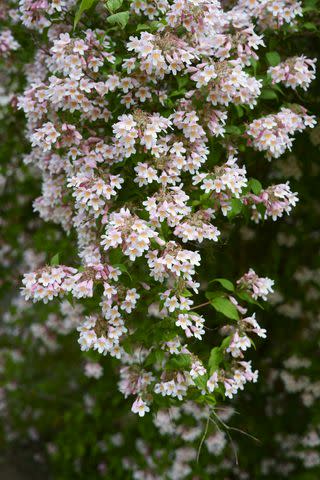
Kevin Kobs/Getty
Botanical Name: Linnaea amabilis (previously Kolkwitzia amabilis)
Sun Exposure: Partial, full
Soil Type: Moist, well-drained, clay, loamy, sandy
Soil pH: Neutral (6.0-8.0)
USDA Hardiness Zone: 4-8
Growth Rate: 24 inches per year
Best suited for the Upper South, the beauty bush is beloved for its abundant pink flowers that attract bees and hummingbirds and complement the deep green foliage. It can be used as either a focal point in the garden or as a stunning hedge. When it reaches maturity, it can reach from 6 to 10 feet tall and wide. It is resistant to drought and deer, and tolerates clay soil. Full sun produces more flowering, but partial shade brings out more vibrant color in its foliage.
Chaste Tree
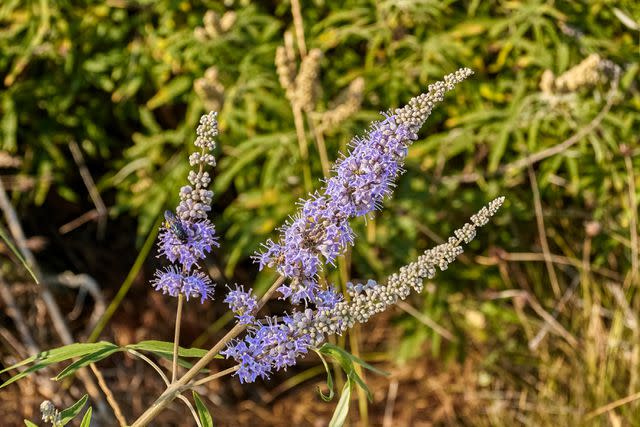
PATSTOCK/Getty
Botanical Name: Vitex agnus-castus
Sun Exposure: Full
Soil Type: Well-drained
Soil pH: Acidic, neutral (6.0-7.0)
USDA Hardiness Zone: 6-9
Growth Rate: 24 inches per year
If you’re planting a chaste tree, just make sure these large, rounded shrubs have plenty of room to grow as they mature at 3 to 20 feet tall and wide. They feature grayish-green leaves and fragrant panicle blooms in shades of white, pink, blue, or lavender. Chaste trees need full sun and can grow in sandy or rocky areas since they are drought-tolerant once established. Pollinators love this plant.
Related: How To Grow And Care For Chaste Tree
Snowball Bush
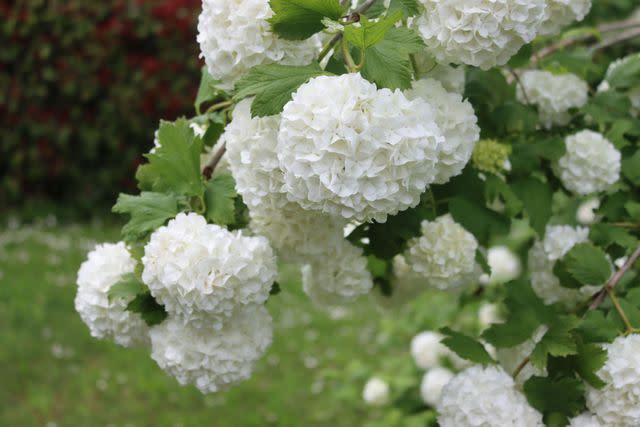
saraTM/Getty
Botanical Name: Viburnum opulus
Sun Exposure: Partial, full
Soil Type: Well-drained, loamy, clay, sandy
Soil pH: Acidic, neutral, alkaline (5.0-8.0)
USDA Hardiness Zone: 3-8
Growth Rate: 24 inches per year
While they might have blooms that look similar, don’t confuse viburnum with the mophead hydrangea. Viburnum opulus, the most recognizable of viburnum varieties, can grow up to 12 feet tall or more with a spread of 12 to 15 feet. They’re not extremely fast growers, but the clouds of flowers that appear in May are worth waiting for and make good cut flowers to enjoy indoors. In fall, their leaves turn red-orange. They prefer moist, loamy soil that is well-drained but can tolerate other soils.
‘Grosso’ Lavender
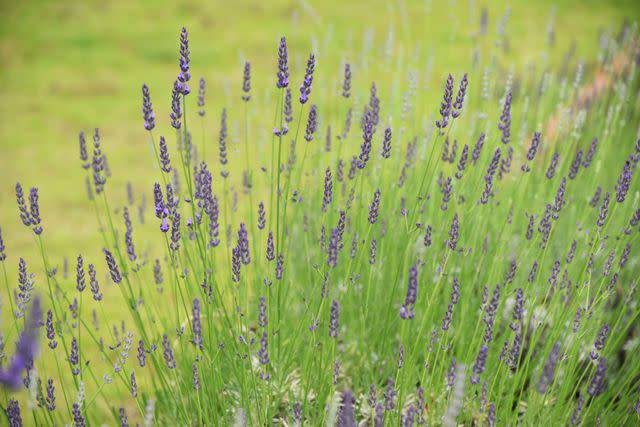
undefined undefined/Getty
Botanical Name: Lavandula × intermedia 'Grosso'
Sun Exposure: Full
Soil Type: Well-drained, sandy
Soil pH: Alkaline (6.5-7.5)
USDA Hardiness Zone: 5-10
Growth Rate: 24 inches per year
Not all lavender varieties are well-suited for the South, nor are all varieties as quick to spread as ‘grosso’ lavender. It features silver foliage and fragrant purple blooms. While mature ‘grosso’ lavender only reaches about 30 inches in height, it can spread up to 48 inches, making it a great option for an area where you need a swath of color—and quick. This large-growing lavender features dark blue flower spikes in summer and is good for drying and culinary uses. It doesn't do well in wet soil or shade but does tolerate cold and humid climates.
Related: How To Grow And Care For A Lavender Plant In The South
Cleyera Bigfoot™
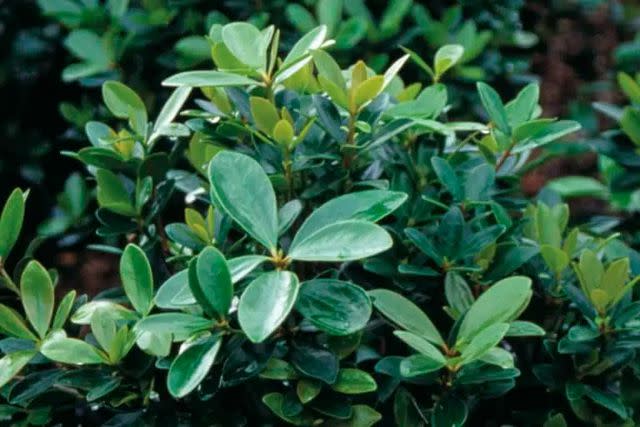
Botanical Name: Ternstroemia gymnanthera 'Sotall'
Sun Exposure: Partial, full sun
Soil Type: Well-drained, rich
Soil pH: Acidic (5.0-6.5)
USDA Hardiness Zone: 7-10
Growth Rate: 18 inches per year
Cleyera Bigfoot™ is a favorite for hedges and privacy screens due to its fast-growing nature and appealing, glossy green foliage. They’re upright growers that are low-maintenance and provide year-round color thanks to their evergreen leaves. They will reach a height of 15 to 20 inches and 5 to 6 inches wide. In hotter climates, they need afternoon shade and can tolerate full shade.
Butterfly Bush
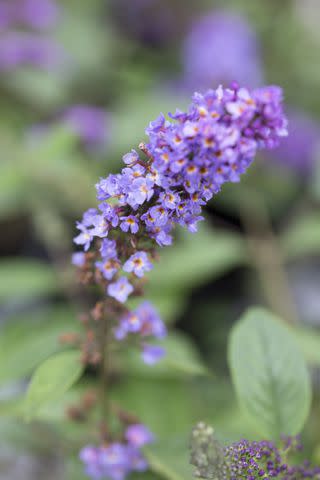
ZoomTravels/Getty
Botanical Name: Buddleia 'Blue Chip' Lo and Beh
Sun Exposure: Full sun
Soil Type: Well-drained, clay, loamy, sandy
Soil pH: Neutral (6.0-8.0)
USDA Hardiness Zone: 5-9
Growth Rate: 24 inches per year
If you’re looking to attract hummingbirds and butterflies to your yard and need a fast-growing shrub, you’ll find both in the butterfly bush. Fragrant, star-shaped flowers with a barely blue appearance in a clustered spike require no deadheading and provide a pretty counterpoint to dark green leaves. Plant in well-drained soil. Plant in an area where the shrub will get eight hours of full sun each day for more flower production and strong stems that don't require staking.
Related: How To Grow And Care For A Butterfly Bush
Beautyberry
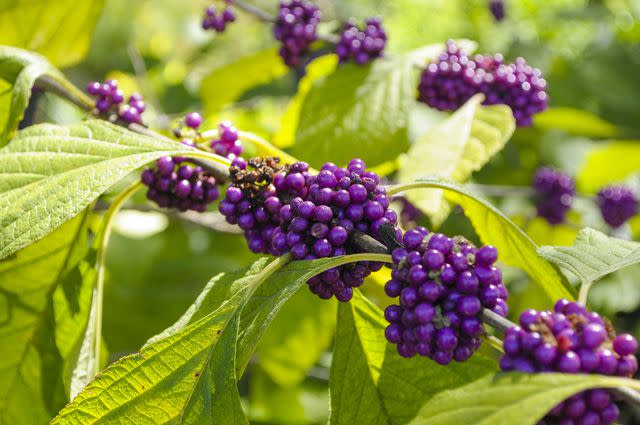
Csaba_F/Getty
Botanical Name: Callicarpa americana
Sun Exposure: Full sun, partial
Soil Type: Moist, well-drained, loamy, clay
Soil pH: Acidic, neutral (5.0-7.0)
USDA Hardiness Zone: 5-10
Growth Rate: 13-24 inches per year
Tiny, bright purple berries that appear in fall and winter and pale purple or pink flowers that burst forth in the summer months give this fast-growing shrub year-round appeal. They’ll attract a wide variety of winter birds and other wildlife to your yard throughout the season. If you’re looking to up the berry production, consider planting beautyberry en masse. Full sun will increase flower and berry production. They are relatively low maintenance, needing pruning to maintain shape and watering during dry periods.
Loropetalum
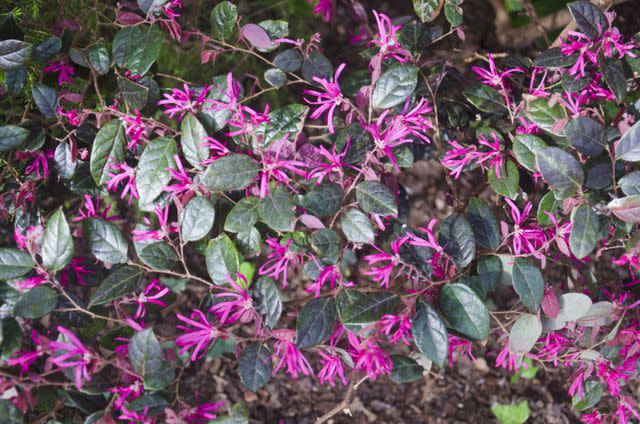
Elizabeth Fernandez/Getty
Botanical Name: Loropetalum chinense
Sun Exposure: Partial, full sun
Soil Type: Well-drained, rich, loamy
Soil pH: Acidic, neutral (4.0-7.0)
USDA Hardiness Zone: 5-10
Growth Rate: 6-24 inches per year
The evergreen shrub features green foliage on arching branches and spidery flowers that appear both at the top of shoots and between the shoot and leaf (known as the leaf axil) in color ranging from off-white to pink. Opt for loropetalum to bring color and texture to your garden early in the spring when other flowering shrubs haven’t yet begun their show. Water when there hasn't been adequate rainfall to keep the soil slightly moist, but don't overwater. They don't like wet roots.
Related: How To Grow And Care For Loropetalum
Cherry Laurel
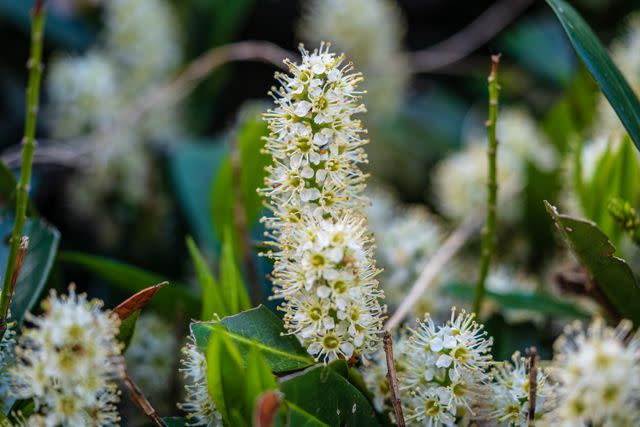
Flottmynd/Getty
Botanical Name: Prunus laurocerasus
Sun Exposure: Partial, full sun
Soil Type: Well-drained
Soil pH: Acidic, alkaline (5.5-7.5)
USDA Hardiness Zone: 5-10
Growth Rate: 24 inches per year
Cherry laurel is a popular shrub in the South, oftentimes used for hedges. While it can grow up to 20 feet tall, it can be maintained in a smaller size if needed. Spiky, white flowers appear in mid-spring but can sometimes be hidden behind the glossy and elongated foliage. Black berries appear in the fall for an interesting encore. Cherry laurel isn't super picky and will tolerate dry, poor, and alkaline soils, salt, as well as heavy pruning. It is toxic to humans.
Fragrant Lilac
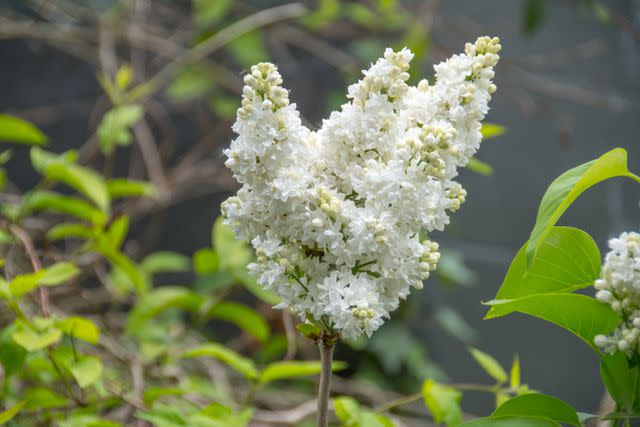
By Eve Livesey/Getty
Botanical Name: Syringa vulgaris
Sun Exposure: Partial, full sun
Soil Type: Moist, well-drained, loamy, sandy, clay
Soil pH: Neutral, alkaline (6.5-7.0)
USDA Hardiness Zone: 3-7
Growth Rate: 13-24 per year
Fragrant lilac will start off as a fast grower, tapering off as it nears maturity. You might catch a whiff of lilac before you catch sight of its fragrant, lilac blooms that appear in April and May. While it’s always tempting to try lilac in warmer USDA zones, this variety isn’t suited for the humid conditions of the lower South. These shrubs prefer cooler summer temperatures. Full sun is best for good flower production, and well-drained soil is essential to prevent root rot.
Red Twig Dogwood

ElrondPeredhil/Getty
Botanical Name: Cornus sericea
Sun Exposure: Partial, full sun
Soil Type: Moist, well-drained, rich, clay
Soil pH: Acidic (5.5-6.5)
USDA Hardiness Zone: 2-8
Growth Rate: 24 inches per year
Ideal for the Upper South, this dogwood that’s named for its red bark is the outlier in a family of otherwise slower-growing varieties. It’s a great choice both for its resiliency and versatility whether as a true shrub or hedge. Once mature, it will reach a height of 7 to 9 feet and 10 feet wide. This dogwood likes consistently moist areas and is found beside streams and ponds. Water during dry spells.
Related: How To Grow And Care For Flowering Dogwood
'Green Giant' Arborvitae
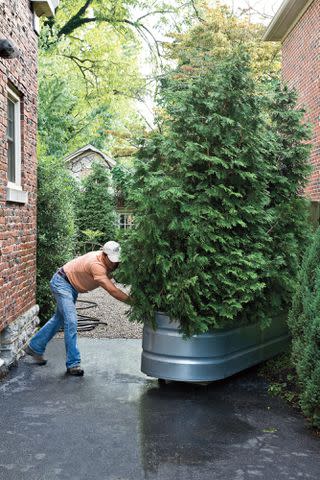
Botanical Name: Thuja ‘Green Giant’
Sun Exposure: Full, partial
Soil Type: Moist, well-drained, clay, loamy
Soil pH: Neutral, alkaline (6.0-8.0)
USDA Hardiness Zone: 5-8
Growth Rate: 3-4 feet per year
These shrubs live up to their name, maturing at up to 40 to 60 feet tall and 12 to 18 feet wide. They are low maintenance due to a uniform, pyramid-shaped growth habit and need little pruning. They can be shaped into a hedging or privacy screen when young. Glossy, scale-like needles remain green all winter long. Plant in a location that gets six to eight hours of sun with good drainage.
Spirea

Botanical Name: Spirea spp.
Sun Exposure: Full, partial
Soil Type: Moist, well-drained, sandy, clay
Soil pH: Acidic, neutral (6.0-7.0)
USDA Hardiness Zone: 4-8
Growth Rate: 24 inches per year
Spirea is easy to grow because it adapts to many different soil types, doesn’t require special care, and grows quickly. Give the shrub full sun, though it will also grow in some shade, and don’t let the soil get soggy. Pink or white flowers emerge from blue-green or chartreuse foliage that changes color in the fall. Prune after the spring bloom and enjoy a rebloom later in the summer.
For more Southern Living news, make sure to sign up for our newsletter!
Read the original article on Southern Living.

